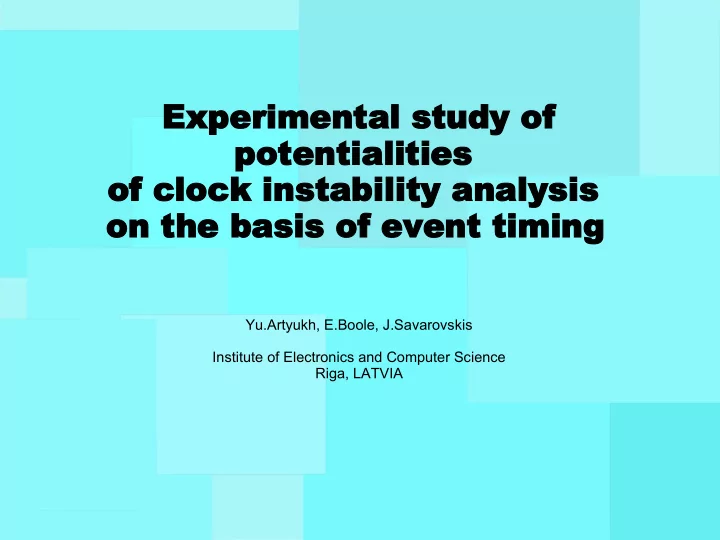

Experimental study of potentialities of clock insta tability ana nalysis s on the basis of event timing Yu.Artyukh, E.Boole, J.Savarovskis Institute of Electronics and Computer Science Riga, LATVIA
Objectives of the research: • Defining the way to measure the clock instability on the basis of high-precision event timer • Specification of the clock instability on the basis of the measurement results • Experimental research concerning the clock instability analysis including: - Random Jitter analysis - Long-term instability analysis - Signal modulation analysis Analysis of experimental data to evaluate potentialities of the approach The 15th International Conference of ELECTRONICS May 17-19, 2011, Kaunas, Lithuania 2
Clock instability measurement by means of event timing Events are defined as clock signal edge crossings at specified level. The 15th International Conference of ELECTRONICS May 17-19, 2011, Kaunas, Lithuania 3
Clock instability characterization Primary function ( Phase instability ) N { AJ k = t k – ( kT 0 + t B )} Derived first difference function ( Period instability ) N { PJ k =AJ k -AJ k-1 } Derived second difference function ( Cycle instability ) N { CJ k =PJ k -PJ k-1 } The 15th International Conference of ELECTRONICS May 17-19, 2011, Kaunas, Lithuania 4
Experimental setup Frequency Frequency (detector of zero crossings, (detector of zero crossings, Standard Standard controllable prescaler) controllable prescaler) Signal Conditioner Signal Conditioner PC PC Input Input EVENT TIMER EVENT TIMER A033-ET A033-ET Analyser Analyser software software Conditioner Event Timer Analyser Software • Crossing level adjustment RMS Time resolution: ~1.9 ps Measurement rate: 20 Mevents/s The 15th International Conference of ELECTRONICS May 17-19, 2011, Kaunas, Lithuania 5
Jitter measurement Random jitter of crystal clock generator Single-shot measurement with picosecond resolution Simultaneous determination of multiple jitter characteristics The 15th International Conference of ELECTRONICS May 17-19, 2011, Kaunas, Lithuania 6
Frequency modulated (FM) signal analysis Period deviation → Frequency deviation Δf t ≈− 1 2 ΔT t T 0 3.3 MHz carrier signal; 500 Hz deviation (period deviation - 45.9ps) Characterizes modulation frequency and its deviation Reveals frequency deviation less than 0.1 Hz The 15th International Conference of ELECTRONICS May 17-19, 2011, Kaunas, Lithuania 7
Amplitude modulated (AM) signal analysis Amplitude modulation is detected by adjustment of comparison level 3.3 MHz carrier signal; 5% AM depth Reveal AM modulation depth less than 0.1% The 15th International Conference of ELECTRONICS May 17-19, 2011, Kaunas, Lithuania 8
AM + FM signal analysis Crossing level adjustment of the Conditioner module effects only amplitude modulated signals. Spectrums of P-jitter function at different comparison levels Level change 3.3 MHz signal with 28 Hz frequency deviation (modulation frequency 10 KHz) + 1% AM depth (modulation frequency 20KHz) Distinguishes AM and FM spectral components of the signal The 15th International Conference of ELECTRONICS May 17-19, 2011, Kaunas, Lithuania 9
Frequency instability measurement Long-term frequency deviation Min = 39682.53 Hz, Max = 39682.55 Hz, Pkp = 0.02 Hz, Mean = 39682.54 Hz, ---------------------------------- Total time = 184.5 sek Frequency over time measurement of signal modulated by 0.006 Hz sine signal. Min = 19230.439 Hz, Max = 19230.441 Hz, Pkp = 0.002 Hz, Mean = 19230.44 Hz, ---------------------------------- Total time = 784.594000 sek Frequency over time measurement of function generator. Reveals very slow frequency deviations Measures the signal frequency deviation with extremely high precision The 15th International Conference of ELECTRONICS May 17-19, 2011, Kaunas, Lithuania 10
Summary • Relatively simple unified technique of clock instability analysis based on high-precision event timer application is discussed. • This technique offers clock instability characterization in different views, including random deviation and spurious modulation of different kinds. • The experimental research of technique showed such facilities as – high-precision jitter measurement; – single-shot and long-term frequency instability measurement; – ability to determine and analyse modulation characteristics of clock; – potential ability to distinguish and determine modulation characteristics of clock signal with amplitude and frequency modulation The study is associated with ERDF project Nr. 2DP/2.1.1.1.0/10/APIA/VIAA/084 “Experimental development of Multi-functional Time Analyser ” The 15th International Conference of ELECTRONICS May 17-19, 2011, Kaunas, Lithuania 11
Recommend
More recommend